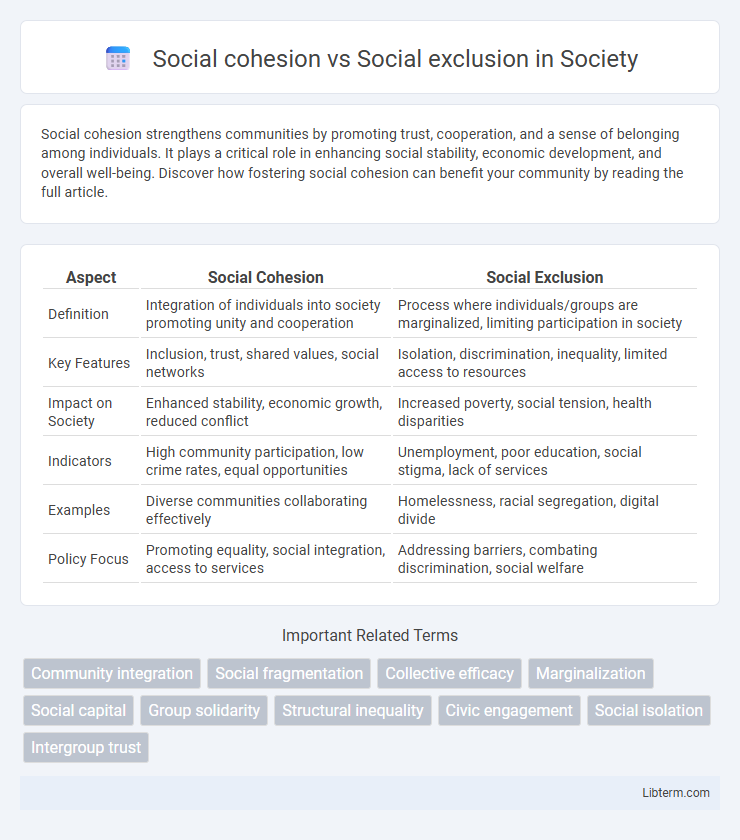Social cohesion strengthens communities by promoting trust, cooperation, and a sense of belonging among individuals. It plays a critical role in enhancing social stability, economic development, and overall well-being. Discover how fostering social cohesion can benefit your community by reading the full article.
Table of Comparison
| Aspect | Social Cohesion | Social Exclusion |
|---|---|---|
| Definition | Integration of individuals into society promoting unity and cooperation | Process where individuals/groups are marginalized, limiting participation in society |
| Key Features | Inclusion, trust, shared values, social networks | Isolation, discrimination, inequality, limited access to resources |
| Impact on Society | Enhanced stability, economic growth, reduced conflict | Increased poverty, social tension, health disparities |
| Indicators | High community participation, low crime rates, equal opportunities | Unemployment, poor education, social stigma, lack of services |
| Examples | Diverse communities collaborating effectively | Homelessness, racial segregation, digital divide |
| Policy Focus | Promoting equality, social integration, access to services | Addressing barriers, combating discrimination, social welfare |
Understanding Social Cohesion: Key Concepts
Social cohesion refers to the strength of relationships and the sense of solidarity among members of a community, emphasizing trust, mutual support, and shared values that foster inclusion. Contrarily, social exclusion occurs when certain groups or individuals are systematically marginalized, limiting their access to resources, rights, and participation in social, economic, and political life. Understanding social cohesion involves analyzing factors such as social capital, community engagement, and equitable opportunities, which are critical for building inclusive societies and reducing disparities.
Defining Social Exclusion and Its Impact
Social exclusion refers to the systematic marginalization of individuals or groups from access to resources, rights, and opportunities essential for full participation in society. Its impact includes increased poverty, restricted social mobility, and weakened community bonds, which undermine social cohesion and perpetuate inequality. Addressing social exclusion is critical to fostering inclusive policies that promote equal access to education, employment, and healthcare.
Historical Perspectives on Social Integration
Historical perspectives on social integration reveal how social cohesion has been vital for stable societies, fostering shared norms, trust, and cooperation among diverse groups. In contrast, social exclusion historically emerged from systemic inequalities, colonialism, and discriminatory policies that marginalized certain populations, leading to fragmented communities. Understanding these dynamics highlights the importance of inclusive policies in overcoming barriers rooted in class, ethnicity, and ideology to promote long-term social harmony.
Drivers of Social Cohesion in Modern Societies
Drivers of social cohesion in modern societies include shared values, equitable access to resources, and inclusive governance that promotes participation across diverse groups. Strong social networks and trust between individuals and institutions enhance cooperation, reducing the risk of social exclusion. Economic stability and educational opportunities further support integration by empowering marginalized populations to engage fully in community life.
Causes and Consequences of Social Exclusion
Social exclusion arises from factors such as poverty, discrimination, lack of education, and limited access to healthcare, isolating individuals or groups from economic, social, and political participation. Consequences of social exclusion include increased inequality, reduced social trust, higher crime rates, and poor mental and physical health outcomes. Addressing root causes through inclusive policies promotes social cohesion by fostering equal opportunities and community integration.
The Role of Policy in Bridging Social Gaps
Effective policy plays a crucial role in bridging social gaps by promoting social cohesion and reducing social exclusion through inclusive legislation, equitable resource distribution, and targeted social programs. Strategies such as affordable housing initiatives, access to quality education, and anti-discrimination laws foster community integration and empower marginalized groups. Policymakers must prioritize participatory decision-making and social equity frameworks to create resilient, unified societies that mitigate the risks of social fragmentation.
Economic Factors Affecting Social Inclusion
Economic factors significantly influence social inclusion by determining access to resources such as employment, education, and healthcare, which are critical for social cohesion. High unemployment rates and income inequality exacerbate social exclusion by limiting individuals' ability to participate fully in economic and social life. Policies targeting poverty reduction, equitable wage distribution, and affordable education enhance social cohesion by fostering an inclusive environment that supports all community members.
Cultural Diversity: Challenge or Opportunity for Cohesion?
Cultural diversity presents a significant challenge to social cohesion when differences lead to misunderstandings, prejudice, or segregation, hindering mutual trust and shared values. However, it also offers an opportunity for social cohesion by enriching societies with varied perspectives, fostering intercultural dialogue, and promoting inclusivity through equitable policies. Effective integration strategies and inclusive cultural narratives are essential to transform diversity into a cohesive social fabric that respects and leverages cultural differences.
Community Initiatives Promoting Social Connectivity
Community initiatives promoting social connectivity play a crucial role in enhancing social cohesion by fostering inclusive environments where diverse groups interact and collaborate. Programs such as neighborhood clubs, cultural festivals, and volunteer projects reduce social exclusion by creating shared spaces that encourage participation, mutual support, and trust among community members. Effective initiatives prioritize accessibility and equitable resource distribution, addressing barriers faced by marginalized populations to strengthen collective identity and social solidarity.
Strategies for Reducing Social Exclusion and Enhancing Unity
Effective strategies for reducing social exclusion and enhancing social cohesion include promoting inclusive education systems that recognize diverse cultural backgrounds and provide equal opportunities for all students. Community-based programs that foster intercultural dialogue and participatory decision-making empower marginalized groups and build mutual trust. Policy initiatives aimed at equitable access to employment, healthcare, and social services further bridge societal divides and strengthen collective identity.
Social cohesion Infographic

 libterm.com
libterm.com